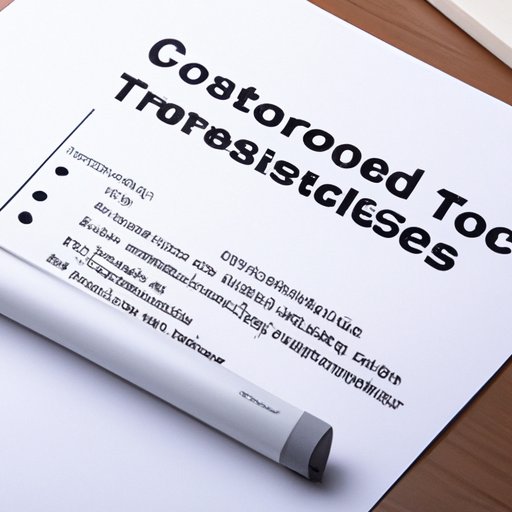
Introduction
Cortisol, also known as the stress hormone, plays a crucial role in the body’s stress response. Cortisol helps regulate blood sugar levels, blood pressure, immune function, and more. However, imbalanced cortisol levels can have negative effects on the body, affecting your overall health and well-being.
Testing cortisol levels is essential to understand the body’s stress response and identifying potential health risks. In this article, we will explore different methods to test cortisol levels, how to interpret cortisol test results, and the importance of balanced cortisol levels for health and well-being.
Why Testing for Cortisol Levels is Important for Your Health
Stress is a natural part of everyday life, and cortisol plays a crucial role in the body’s response to stress. Cortisol levels naturally fluctuate throughout the day, with the highest levels in the morning and the lowest levels at night.
However, imbalanced cortisol levels can have negative effects on the body. High cortisol levels can lead to anxiety, depression, weight gain, and more. On the other hand, low cortisol levels can cause fatigue, weakness, and reduced immune function.
Testing cortisol levels is vital to identify imbalances and potential health risks. It can help with the diagnosis of conditions such as Cushing’s syndrome and Addison’s disease, which affect cortisol production in the body.
Different Methods to Test Cortisol Levels: Pros and Cons
There are three primary methods to test cortisol levels: saliva testing, blood testing, and urine testing. All methods have pros and cons that are worth considering.
Saliva Testing: Saliva testing is non-invasive and convenient, and allows for multiple tests throughout the day. It is also cost-effective and can be done in the comfort of your home. However, saliva testing is not always accurate, as other factors such as recent food or drink consumption can affect cortisol levels in saliva.
Blood Testing: Blood testing is the most widely accepted and accurate method for testing cortisol levels. It can accurately identify imbalances and underlying health conditions. However, it is not as convenient as saliva testing, and also requires a blood draw, which can be uncomfortable for some patients.
Urine Testing: Urine testing can provide a more comprehensive view of cortisol levels over a 24-hour period. It is also non-invasive and can be done at home. However, it is not as accurate as blood testing and may not accurately reflect cortisol levels at a specific time of day.
How to Interpret Cortisol Test Results
Interpreting cortisol test results correctly is vital to understanding the body’s stress response. Cortisol levels are measured in either micrograms per deciliter (mcg/dL) or picomoles per liter (pmol/L).
Cortisol reference ranges can vary depending on the testing method used. However, a typical reference range for cortisol levels is between 6-23 mcg/dL or 138-635 nmol/L in the morning, and 2-11 mcg/dL or 55-300 nmol/L in the afternoon or evening.
High cortisol levels can indicate conditions such as Cushing’s syndrome, while low cortisol levels can indicate Addison’s disease. It is essential to interpret cortisol test results correctly to identify any potential underlying health conditions and take appropriate action.

Cortisol Tests at Home: What You Need to Know
At-home cortisol tests are becoming increasingly popular due to their convenience and cost-effectiveness. However, before trying at-home cortisol tests, there are some important considerations and precautions to keep in mind.
Firstly, at-home tests may not be as accurate as tests done in a laboratory, as they are not always conducted under controlled conditions. Secondly, it is essential to ensure that the test is from a reputable company and is clinically validated. Finally, it is crucial to follow the instructions carefully to obtain accurate results.
The Best Labs to Test Cortisol Levels: A Comparison
When choosing a lab to test cortisol levels, there are several factors to consider, such as cost, accuracy, and turnaround time. Here are some of the best labs for testing cortisol levels:
ZRT Laboratory: ZRT Laboratory offers saliva testing kits that can be done at home. The cost of testing ranges from $98-$325, depending on the type of test kit.
Quest Diagnostics: Quest Diagnostics offers blood testing for cortisol levels. The cost can vary depending on your insurance coverage, with the average cost ranging from $25-$250.
LabCorp: LabCorp also offers blood testing for cortisol levels. The cost can vary depending on your insurance coverage, with average costs ranging from $25-$300.
How Often Should You Test Your Cortisol Levels and Why
The frequency of cortisol testing can vary depending on your health, age, and other underlying health conditions. Generally, it is recommended to test cortisol levels every six months to a year.
Regular cortisol testing can help identify imbalances and potential health risks early on, allowing for timely intervention. Additionally, it can help monitor the effectiveness of any treatment or lifestyle changes made to improve cortisol levels.
Natural Ways to Lower Cortisol Levels: An Alternative to Testing
There are several natural ways to reduce cortisol levels in the body. These techniques include:
– Yoga and meditation: Yoga and meditation have been shown to reduce cortisol levels and manage stress effectively.
– Exercise: Regular exercise has been shown to reduce cortisol levels and improve overall health and well-being.
– Good sleep hygiene: Getting quality sleep and good sleep hygiene can help reduce cortisol levels and improve overall health.
Implementing these natural techniques can help reduce cortisol levels and manage overall stress, without the need for testing.
Conclusion
Cortisol plays a vital role in the body’s stress response, and imbalanced cortisol levels can have negative effects on overall health and well-being. Testing cortisol levels is essential to identify imbalances and potential health risks early on.
There are several methods for testing cortisol levels, each with their pros and cons. It is essential to interpret cortisol test results correctly and choose a reputable lab for testing. Additionally, natural methods such as yoga, meditation, and exercise can help reduce cortisol levels and manage overall stress without the need for testing. By taking care of your cortisol levels, you can improve your overall health and well-being.




